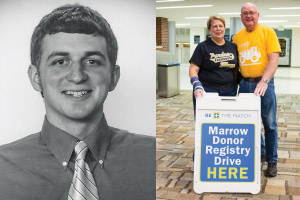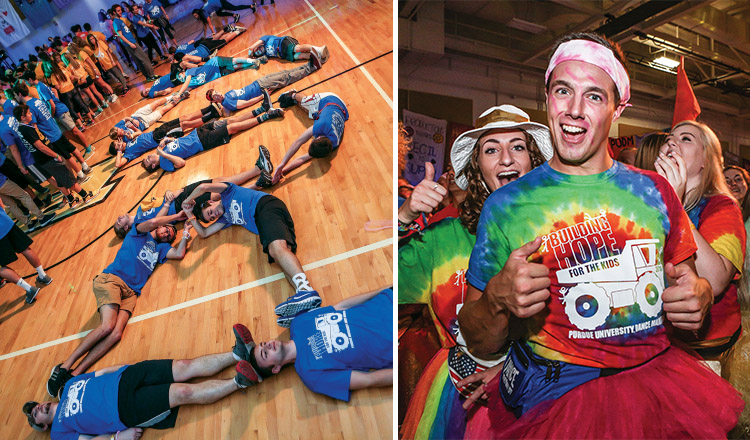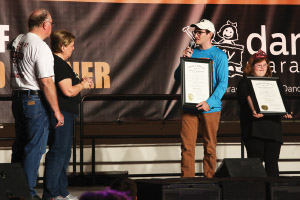The slips of paper, naturally, are faded. It’s been nearly 10 years since John Romine (AS A’08) held them in his hands and scribbled what were, essentially, his last requests and stuffed them in a folder.
John was dying of Hodgkin’s lymphoma, unable to secure a bone-marrow match in time to save his life, and lying in a bed at Riley Hospital for Children in Indianapolis. Knowing he was declining — and unable to speak well because of an oxygen mask and a scratchy voice as a result of a botched surgery that clipped his vocal cord — John took to writing in his final days. In red ink on one page of the computer paper provided by a nurse, John wrote, “Don’t stop doing registration drives. You cannot stop. Because if not for me, for someone else.” That particular wish has fueled Mark (A’76) and Carol (HHS’76) Romine ever since.
The Romines started working with Be The Match, the largest bone-marrow registry in the world, in an effort to find a match for John. But once he was gone, how could they keep going?
“You think, ‘I don’t want to do them anymore. It’s not necessary. It was for you that we did that,’” says Carol, whose tears left stains on those papers, rarely pulled out these days. “But he said, ‘It’s important.’ So although we can’t do this to help him anymore, maybe we can for somebody else because that’s what he really wanted us to do. It is really hard — extremely hard. There are tears any time we go to a registration drive.” Because, now, when they hold drives, John’s not there. He can’t be saved. But someone else can.

Mark and Carol have pressed on, generating courage and gearing up every year for one specific occasion: Purdue University Dance Marathon (PUDM), the 18-hour event that raises money and awareness for Riley each November. There, the Romines tell John’s story: how a 22-year-old kid who was a member of FarmHouse Fraternity wanted desperately to live, to thrive, and to earn his bachelor’s degree but was robbed of the chance.
There, they sit behind a Be The Match registration table, imploring folks to sign up to donate blood, stem cells, or marrow. When someone registers, Carol reaches out to shake a hand, squeezing tightly, and says, “Thank you for doing that, and I hope you get a chance to save somebody’s life — because wouldn’t that be so awesome?”
There, they were presented with the Distinguished Hoosier Award in 2016. There, they’ve become icons.
Not everyone knows John’s story in Hope, Indiana, where the Romines live, but every time they come to Purdue, they’re spotted. People often say they are eagerly waiting to donate, even asking if they need to reregister (they can’t). At one recent PUDM, a couple showed Carol a photo of their dog — its name was Romine.

The Romines aren’t quite sure how many people have registered for Be The Match, but they figure it’s close to 3,000 when counting all of the drives they’ve done since 2008. “Once a week, there is now a match for someone who signed up at Purdue,” Mark says. “Not everybody signs up at Dance Marathon, but that’s the vast majority of them.”
And yet Mark and Carol insist the surge in registrations is not about them. They point to the students who participate in PUDM. “It’s about what those young people can do,” Carol says. “When they sign up, they have to be 18, and they’re registered until they’re 60. The willingness to do that and be committed, it’s just amazing.”
But the students may not be so quick to take credit. Becca Anglen, a fifth-year cellular biology major, never met John. But as an active participant — and now PUDM president — she has been inspired by him because of Mark and Carol.
“They do a really good job of keeping John’s spirit alive,” Anglen says. “They’ve memorialized him in a way that is happy and celebratory instead of in a way that invites pity. They celebrate their family and friends, and they celebrate all of the students who put on this event. They’re just very, very loving at everything they do, and they make a difference in a lot of people’s lives.”

Not that it’s easy. Every single year when Mark and Carol take the stage for a portion of PUDM, they get emotional. But every single year, they keep doing it. For John. For kids like him who need saving.
“One of the last things he said was, ‘Don’t forget me,’” Mark says. “It’s very inspiring to be around these students because you hear a lot of negativity about young people in society. To be with a group of them who are working to help children and other people is an honor. I get to thinking about John, and it’s hard for me. But I love seeing those young people — they’re the real heroes. They’re the ones doing the work. We’re just carrying a story. It’s a love story. But those young people are making it work.”

